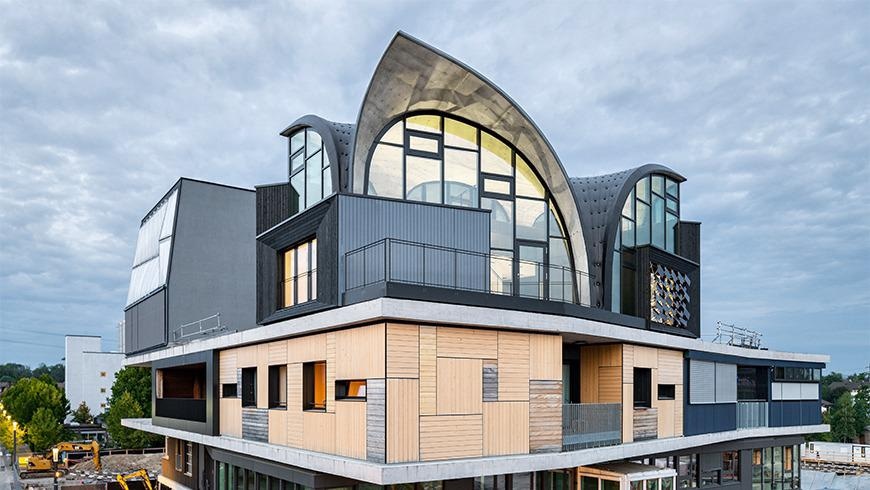HiLO, the latest NEST unit, integrates medieval building principles with futuristic construction techniques. The two-story building unit with an attractive doubly-curved concrete roof and a novel, lightweight funicular floor system was drawn from historical construction methods. It is planned and built using state-of-the-art computational design and fabrication methods.
 The HiLo unit sits on the top platform of the NEST research and innovation building on the Empa campus in Dubendorf, Switzerland. Image Credit: Roman Keller.
The HiLo unit sits on the top platform of the NEST research and innovation building on the Empa campus in Dubendorf, Switzerland. Image Credit: Roman Keller.
A team of scientists led by Philippe Block, Professor of Architecture and Structures, and Arno Schlueter, Professor of Architecture and Building Systems in collaboration with industrial partners have uncovered the integration method of lightweight structures and efficient construction methods with intelligent and adaptive building systems, for decreasing both embodied and operational emission in the construction and building industry.
Resource-Efficient Concrete Structures
The striking roof of the unit draws its load-bearing capacity from its highly curved geometry jointly with a concrete sandwich structure, made of two thin layers of reinforced concrete linked by a grid of concrete ribs and steel anchors.
The roof was erected using flexible formwork to save large volumes of formwork material. This arrangement comprised a tensioned cable net enveloped with a thin membrane onto which the concrete was sprayed.
The researchers aim to use the least material possible in the structure for the mezzanine floors for the two-story unit. With the use of a rib-stiffened funicular shell instead of a flat plate, the lightweight system of HiLo is capable of using over 70% fewer materials than the traditional floor slabs in reinforced concrete.
Additionally, the digital production techniques enabled the integration of ventilation, cooling and low-temperature heating systems into the floor structure to attain a higher reduction in material and volume.
Learning Building Technology
The HiLo unit is fitted with an adaptive solar façade developed by the group led by Schlueter. It comprises 30 photovoltaic modules that can be aligned with the sun. It is also possible to control the entry of sunlight into the room for passive heating or to reduce cooling requirements.
The adaptive solar façade is one of a series of innovative building technology components designed for efficient indoor climate regulation. While working, the team constantly optimized the interplay of each technology using machine learning technology and prioritizing the users so as to discover how ideal indoor conditions can be obtained using as minimal energy and emission as possible.
Research and Industry Learn from Each Other
HiLo means “High performance-Low emission.” The unit enables researchers to verify the designing aspects of the construction and operation of building to attain energy- and resource efficiency, meanwhile ensuring an attractive architectural space and high level of comfort.
HiLo is the eighth module in the NEST experimental buildings, situated on the campus of the two research institutions Empa and Eawag in Duebendorf, Switzerland (close to Zurich). In the modular research and innovation building, scientists and industry associates can verify and develop new building and energy technologies in temporary building modules or units and under “real-life” scenarios.
NEST unit HiLo - "High Performance - Low Emissions"
Video Credit: Empa
Source: https://www.empa.ch/web/empa/